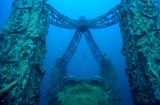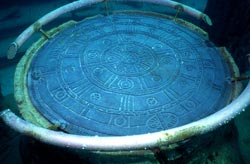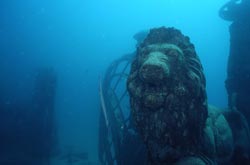
A Watery Resting Place
Florida coastal reef supports the living and the dead
- By Debbie Bolles
- May 09, 2008
 On the ocean floor, three miles off the coast of Miami, an underwater city teems with aquatic life and exposes "ruins" from a lost age. A bronze plaque beside a starfish sculpture gives away the fact that while beautiful, this reef is actually artificial.
On the ocean floor, three miles off the coast of Miami, an underwater city teems with aquatic life and exposes "ruins" from a lost age. A bronze plaque beside a starfish sculpture gives away the fact that while beautiful, this reef is actually artificial.
But the building of a manmade reef is not unusual, given a booming Atlantic Ocean recreational diving and snorkeling industry. What makes the Neptune Memorial Reef different is that it doubles as an underwater graveyard.
The intricately designed concrete starfish contains the cremated remains of a woman. At another part of the reef, cremated remains mixed with sand and concrete form a column.
"By becoming part of this artificial reef, they can contribute to life after death, meaning that these marine creatures will have a place to live and dwell," said Jerry Norman, president and CEO of the Neptune Society, a group that together with Afterlife Services owns and operates the reef.
Completed in November 2007 and free for viewing by divers, snorkelers, or visitors passing by on glass-bottom boats, the reef is the only constructed underwater graveyard in the world, according to Norman. The group received a permit from the U.S. Army Corps of Engineers to build it and the U.S. Department of Environmental Resource Management gave the project a nod and monitors its environmental impact.
Scattering cremated ashes at sea is legal three miles off the U.S. shore, Norman said. Cremated remains, as part of a permanent sculpture, will not dissolve or impact water quality in the ocean, he added. If anything, Norman said cremation and permanent placement of remains at the reef are more environmentally friendly than cemetery burials.
"Traditional funeral services have elements that involve polluting the environment, everything from embalming fluids to chemical fertilization [of landscaped burial plots] to greenhouse gas emissions because lawnmowers are used to maintain [cemeteries]," said Norman, adding that cremation is "growing as an option and accounts for over 30 percent" of funeral decisions nationally.
 Art Even in Death
Art Even in Death
Remains placement at the reef can cost between $1,495 and $8,000. The average placement is $2,600. Individuals can cremate the body independently or through Neptune, owner of the nation’s largest cremation service.
If cremated elsewhere, the remains are shipped to Neptune by registered mail. The ashes then are mixed with sand and concrete into a pottery material and placed into the selected mold, such as a lion, column, or starfish.
The permanent sculpture is placed at a reef location chosen by the client, accompanied by a bronze memorial name marker. At the ocean surface, buoys identify the 16-acre area as Neptune Memorial Reef.
Construction of the reef began in late 2003. Weather delayed the project’s finish until this past fall, when the "Lost City" comprised of concrete and bronze structures was successfully placed on the ocean floor.
Neptune officials expect the reef, which mimics Atlantis, to become a large and active marine research site. It also will act as an undersea breakwater, reducing erosion.
 "Its purpose is to improve and create fish habitat off the coast of Florida and re-establish coral growth in an area that previously was barren sand," said Norman.
"Its purpose is to improve and create fish habitat off the coast of Florida and re-establish coral growth in an area that previously was barren sand," said Norman.
"With the help of time and nature, this underwater memorial city will become a living reef of colorful marine life, coral growth, and a fish habitat holding secure the remembrances of the dearly departed for all time," a Neptune press release stated.
For more information or a virtual tour of the reef, go to www.nmreef.com.
About the Author
Debbie Bolles is managing editor of Water & Wastewater News.